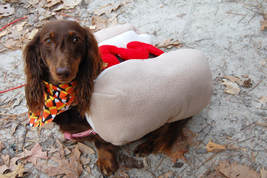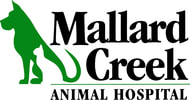Laurie Anne Walden, DVM  Halloween is just a few days away! It’s a fun holiday, but it can be stressful and even dangerous for some pets. Here are 8 tips to keep your pets safe during the holiday. 1. Keep your pets away from candy! Be sure the candy bowl is out of their reach, and confine them to another part of the house while your children are diving into their treat bags. If your pet eats candy, call a veterinarian right away. These are some of the treats that are hazardous to pets:
2. Watch for other things your pets might swallow, like lollipop sticks and candy wrappers. 3. Bring your cats indoors. 4. Keep your pets in a quiet room away from the front door. If they react to doorbells, consider using one of the tactics that families with sleeping babies in my neighborhood use:
5. Keep glow sticks and glow bracelets away from your pets. These are usually not toxic, but the liquid inside tastes terrible and can cause drooling and pawing at the mouth. 6. If you dress your pet in a costume, be sure the costume doesn’t block its vision, breathing, hearing, or movement. Watch for small parts or loose ends that your pet might swallow. Don't leave a pet in a costume unattended. 7. Keep your pets away from electrical cords and lit candles. 8. Be sure your pets are wearing collars with identification tags or have microchips in case they escape from the house while the door is open. Giving your pets a quiet place indoors to get away from the activity—and away from the candy—is usually the best way to keep them calm and safe during holidays. Happy Halloween! Mary Fluke, DVMAssociate Veterinarian, Mallard Creek Animal Hospital  A tale of two Labs…or why it’s a good idea to not let your dog get fat. Life teaches us lessons sometimes, often unexpectedly. That happened to me a few days ago. It was a busy morning here at the practice and one of my cases was a young Black Lab, about a year old, presenting because of a skin fold infection. She was a really nice dog with a really nice owner and a problem that will likely get better with the treatment, but part of her issue was that she is about 10-15 lbs overweight which is why the skin fold had gotten so prominent. Her owner was in the habit of feeding all her dogs together out of one bowl and wasn’t really sure how much food she put out, reasoning that it was best to have food available all the time so that the dogs wouldn’t be hungry. We talked about how to change how she feeds her dogs so they won’t feel the need to compete with each other for food and how the amount on the back of the bag was almost always too much. We set a goal for about how much food to give the dogs to get them, and particularly this dog, back to normal body weights. A few years ago, Purina completed a project called the Life Span Study. They started with fifty 8 week old Labrador Retriever puppies, in pairs, with one being allowed to eat as much as it wanted each day, and the other pup being fed 10% less. As they grew up, the pups that ate all they wanted grew faster and got bigger at a younger age and wound up being overweight when they reached adulthood. The pups that were fed the lesser amount grew a little slower—they got just as big in the end, but were not overweight as adults. Various tests were done on the dogs including evaluation for hip dysplasia. The dogs fed free choice as pups were more likely to show signs of hip dysplasia on radiographs than their limited fed friends, even though they all came from the same genetic background. The dogs were maintained through their lives in the two groups. The overweight dogs weren’t allowed to eat all they wanted (that would actually have been cruel because some of them would have become even fatter) but they were maintained in a consistently overweight condition, about on a par with what a lot of people would consider to be pretty typical in a pet. The lean dogs were fed to keep them at a normal healthy weight, with good muscle definition and very little body fat. In every other way, the dogs were managed identically. They all got regular physical exams and blood tests and had annual xrays to check for hip problems, arthritis, and any other issues that might turn up. Because these were Labrador Retrievers, the most common problem that they developed as they got older was osteoarthritis, not just hip problems but arthritis in other joints as well. As they started having issues, they were treated to maintain their comfort and good quality of life, but eventually they all reached the end of their natural life spans. Imagine, 50 dogs living their whole lives, in the same environment with the same care except for one thing—half of them were fat and half of them were lean. They all got the same kinds of diseases, but the fat dogs got them younger and tended to have a harder time being managed. The lean dogs stayed healthier longer and didn’t require as much medical intervention—their problems were easier to control. Most of the fat dogs died by the time that they were 10 years old. Their lean buddies made it to 12 years as a rule. The last of the dogs died at 14 years old. Pretty powerful lesson, right? Keep your dog lean and she will live to be about 2 years older than if you let her get fat. She will stay comfortable longer and her health problems will be easier to control. And it’s so easy since dogs don’t fix their own food. As a rule, owners have total control over how much food their pets eat since the dogs can’t order take out or go raid the cookie aisle at the grocery store. All we have to do as owners is put less food in the bowl. Easy. Cheap. And really powerful in terms of keeping our dogs healthy and with us longer. That same day I saw another Black Lab. This one was old and disabled due to terrible arthritis. He was also about 10 lb overweight, just like the youngster that I saw earlier in the day. His owners brought him in to be put to sleep because he was having so much trouble getting up and walking. Part of me wished I could wave a wand and trim the 10 lbs. off—he might have had a few more months if he hadn’t had to lug around the extra weight, but the time for that intervention was long past. I couldn’t help comparing these two dogs, one at the start of her life and one at the end of his. Nobody knows what the future holds but when there is something easy and simple to do which can prevent needless health problems and allow a longer life span, why not do it? I hope that I was able to give the owner of the young dog the knowledge and tools to correct this problem so her pet can be as healthy and happy as possible throughout her life. I’m sad for the dog that died and his owners who miss him, but I’m glad he’s not hurting any more. Life teaches us lessons. All we have to do is pay attention. How to keep your dog at a healthy body weight: For puppies, feed a food designed for your type of dog, regular puppy food for smaller breeds, large breed puppy food for the bigger breeds. Follow the feeding instructions on the back of the bag for the age and breed, increasing gradually as the pup grows up. If a range is suggested, feed the amount at the lower end of the range. Once the pup is nearly at adult size (6 months for small breeds, 8-10 months for medium and larger breeds, 12-14 for giant breeds), switch to adult dog food and tone down the amount, especially after the dog is spayed/neutered. As a rule, most grown up spayed/neutered dogs need about a cup of typical dry dog food per 20 lb of normal body weight for small breeds, per 25 lb for medium breeds, and per 30 lb for larger breeds. A 75 lb Lab who is moderately active will probably eat about 2 ½ to maybe 3 cups a day. This amount will vary based on the calorie value of the food, the amount of exercise the dog gets every day, and the dog’s innate metabolism. Unfortunately, the guidelines on the back of the bag almost always result in overfeeding of grown up dogs so keep monitoring body condition and weight. If a dog is at a normal body condition, you should be able to pick up the skin over the last rib and not feel fat under the skin. Ribs should be easily felt but not stick out. You should be able to see your dog’s waist when viewed from above, and his belly should be tucked up when seen from the side. The body wall should indent a bit just behind the last rib. If your dog is too thin, feed him more. If she is too heavy, feed her less. If you are not sure, ask your vet for an honest assessment of your dog’s weight, including a body condition score. Purina has published a system which goes from 1 to 9 where 5 is just about normal. Iams has a similar system which goes from 1 to 5 (3 is normal). If you are already feeding a very low amount of food and your dog is persistently overweight, it’s worth checking to see if there might be a health issue at the root of the problem. Some dogs may require an ultra low calorie prescription diet to achieve weight loss, but this is only necessary if feeding an appropriate amount of regular food isn’t working. Your vet can help you figure out if a diet change is needed. Laurie Anne Walden, DVM According to the Association for Pet Obesity Prevention, up to 54% of dogs and 59% of cats in the United States are overweight. That’s more than 40 million dogs and 50 million cats. Is your pet one of them? Obesity has been linked to arthritis, diabetes, heart disease, immune system disorders, liver disease, and other health problems in pets. In recognition of National Pet Obesity Awareness Day (October 11), here’s how to tell if your pet is overweight.
Body condition scoring Body condition scoring assigns a number to a pet’s condition to make it easier to track changes over time. Body condition score charts typically use either a 5-point or a 9-point scale. The ideal body condition score is 3 on a 5-point scale or 5 on a 9-point scale. Check out one of these body condition charts to see where your pet falls on the scale:
Medical problems Always bring your pet in for a physical examination before reducing its calorie intake or starting an exercise program. Some medical problems can cause weight gain. Pets with these conditions might need to go on a diet, but they also need treatment:
Other medical conditions can mimic obesity. A pet with one of these conditions might have a big belly but actually be thin overall, and restricting its food could be harmful:
We’re happy to discuss your pet’s weight with you and suggest a diet and exercise plan for your pet that will work for your family. (Telling you “no table food EVER” is not very helpful if you have a toddler in the food-throwing stage). And remember: your pet’s weight is not a reflection of your own health or of how much you love your pet. If we tell you your pet needs to lose weight, it’s only because we want your pet to live a long life and be as healthy as possible. For more information Association for Pet Obesity Prevention website Obesity (dog): American Animal Hospital Association website Obesity: The Cat Community website October 13, 2017 Photo by Almi Mary Fluke, DVM Veterinarian at Mallard Creek for over 20 years  I attend at least 20 hours of continuing education seminars every year to maintain my veterinary license. This week I spent a day listening to Dr. Sharon Gwaltney-Brant, a nationally recognized veterinary toxicologist who (among other things) spent 13 years working for the ASPCA Animal Poison Control Hotline. The final topic of the day was Internet Rumors. Not only is that super ironic (a toxicologist talking about toxic information), it was also apropos given that the folks at the poison control centers field tons of calls about internet rumors. That puts them in a unique position to know what the latest posts are that are making the rounds, or resurfacing again for the umpty umpteenth time. Much of the information that I’m offering here is paraphrased from Dr. Gwaltney-Brant’s notes—I share it with her permission. Internet rumors are the latest form of urban legend, a form of folklore that’s been around as long as there have been campfires. Usually the topic is something horrific or embarrassing, purportedly having happened to an actual person, sounding plausible, and seemingly intended to provide information to help the reader avoid a similar event. That’s all well and good, but in this day of “fake news,” such rumors can disseminate far and wide and FAST. Untrue rumors cause real harm to individuals, businesses, and, oh I don’t know, the country??? The common features of an internet rumor are:
So what’s a poor pet lover to do when he or she sees something on Facebook or Twitter saying that heartworm prevention kills dogs or the FDA is investigating a pet food company? For starters, don’t hit “share” until you’ve determined whether or not the post is real. The quickest way to avoid sharing an internet rumor is to check it on www.snopes.com or www.truthorfiction.com or your favorite fact check site. Most of the time you’ll find the answer right there and you can post the link on your friend’s Facebook page (or message the person privately if you still think it’s rude to embarrass someone publicly). If Snopes or Truthorfiction don’t give you the answer, try doing an internet search using some of the keywords or names from the post and see what that yields. I have learned a lot of very interesting thing in the process of fact checking internet rumors. Just because there’s a website (www.[insertdrugorproductnamehere]killedmydog.com) doesn’t make something true. Get in the habit of fact checking with an open mind. You’ll be surprised what you might discover! |
AuthorLaurie Anne Walden, DVM Categories
All
Archives
June 2024
The contents of this blog are for information only and should not substitute for advice from a veterinarian who has examined the animal. All blog content is copyrighted by Mallard Creek Animal Hospital and may not be copied, reproduced, transmitted, or distributed without permission.
|
- Home
- About
- Our Services
- Our Team
-
Client Education Center
- AKC: Spaying and Neutering your Puppy
- Animal Poison Control
- ASPCA Poisonous Plants
- AVMA: Spaying and Neutering your pet
- Biting Puppies
- Boarding Your Dog
- Caring for the Senior Cat
- Cats and Claws
- FDA warning - Bone treats
- Force Free Alliance of Charlotte Trainers
- Getting your Cat to the Vet - AAFP
- Holiday Hazards
- How To Feed Cats for Good Health
- How to Get the Most Out of your Annual Exam
- Indoor Cat Initiative - OSU
- Introducing Your Dog to Your Baby
- Moving Your Cat to a New Home
- Muzzle Training
- Osteoarthritis Checklist for Cats
- What To Do When You Find a Stray
- Our Online Store
- Dr. Walden's Blog
- Client Center
- Contact
- Cat Enrichment Month 2024
|
Office Hours
Monday through Friday 7:30 am to 6:00 pm
|
Mallard Creek Animal Hospital
2110 Ben Craig Dr. Suite 100
|
Site powered by Weebly. Managed by IDEXX Laboratories

 RSS Feed
RSS Feed